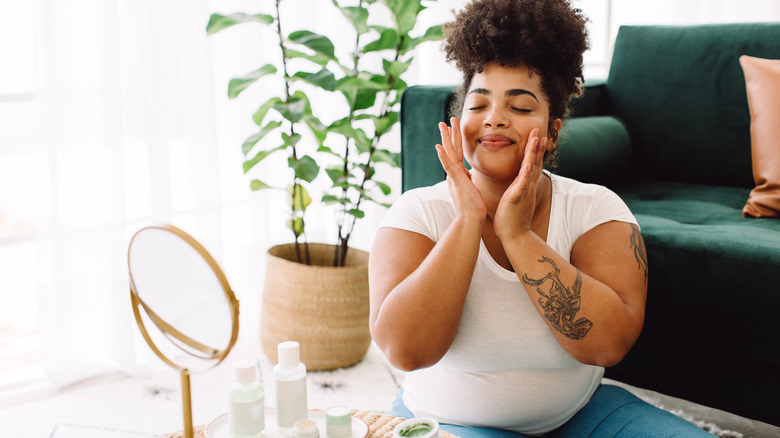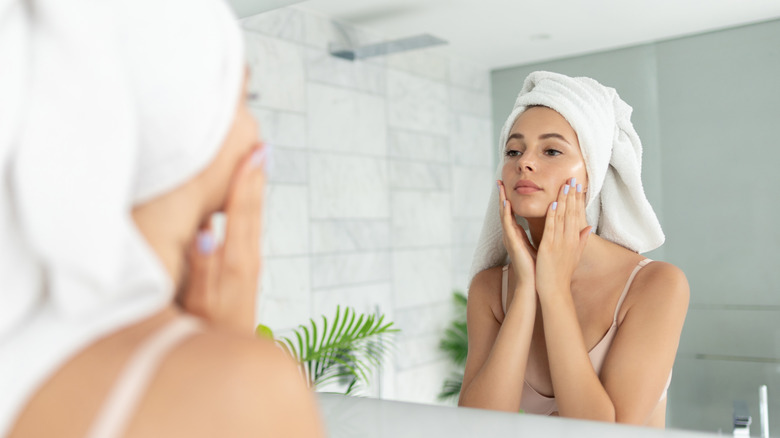Why Intuitive Skincare Is The Key To Your Best Complexion Ever
A solid skincare routine is essential, whether you deal with acne, have Sahara-like dryness, or just want to protect yourself from the sun's damaging rays. However, even the best routines need a little tweaking at times, especially as our skin changes from day to day. Factors like the weather, menstruation, and even things like stress and diet can play a role in oil production and overall skin health. And sometimes, holy grail products containing actives (like vitamin C and retinols) or heavy moisturizers can do more harm than good when overused.
In short, what worked for your skin yesterday may not work for it today. That's where intuitive skincare comes in. According to Clean Beauty School, intuitive skincare, like its predecessor intuitive eating, is all about listening to your body and giving it what it needs. Just as you might choose a certain snack based on your energy levels and dietary needs, skincare products should be chosen based on how your skin looks and feels on any given day.
Here's how an intuitive approach works and ways to adjust your skincare routine to boost your complexion.
When intuitive skincare makes sense
You've done your research and tested numerous products to create the ultimate skincare routine. So when should you stray from your standard regimen and follow your intuition? The answer isn't cut and dry, according to experts. "It's just a matter of getting to know your skin and getting the consumer to understand that they're the boss — this is your routine," Tiffany Masterson, founder of skincare brand Drunk Elephant, explained to Toronto Star. "There are so many factors that come into play when you're trying to decide what to use on your skin."
Part of the process is learning about what triggers your skin issues. Emily Parr, creator of the intuitive skincare brand Current State, offered the example of eating acne-causing cheese to Well+Good. Rather than panicking or running to the dermatologist to fix your dairy-induced breakout, "you should have an arsenal of products that you can swap around to tackle any skin concern that comes up," she says. Once your complexion is back to normal, you can return to your regular routine.
How to monitor and respond to skin fluctuations
A sudden eruption of painful, inflamed pimples may be easy to spot, but acne isn't the only skin issue to watch out for when practicing intuitive skincare. According to Clean Beauty School, it's essential to also observe changes to your skin's moisture levels (look for more lines and wrinkles, which indicate a lack of moisture), oil production (check for shine and a greasy feeling), and texture (flakes are usually a result of dryness, while bumps can relate to excess oil and pore-clogging ingredients).
Women who menstruate may also want to track their menstrual cycles along with the skin changes they notice. Though everyone's body is different, it's common to experience dullness during menstruation and oiliness during ovulation.
Intuitively responding to skin changes isn't so hard, as long as you know which products to reach for and when. For example, parched skin in the winter may require a heavier moisturizer or an extra layer of hydrating essence. And uneven skin texture is often a sign that it's time to exfoliate. Finally, just as you might treat yourself to the occasional cup of ice cream with intuitive eating, intuitive skincare allows room for ingredients you may have been told to avoid, as Dara Kennedy, the owner of a clean-beauty boutique, shared with Byrdie. So go take a look in the mirror, study your skin, and give it what it's craving.


